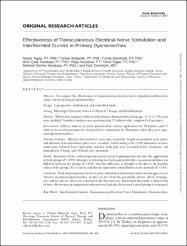Effectiveness of transcutaneous electrical nerve stimulation and interferential current in primary dysmenorrhea

View/
Date
2007Author
Tuğay, NazanAkbayrak, Türkan
Demirtürk, Funda
Karakaya, İlkim Çıtak
Kocaacar, Özge
Tuğay, Umut
Demirtürk, Fazlı
Metadata
Show full item recordAbstract
Objective. To compare the effectiveness of transcutaneous electrical nerve stimulation and interferential current in primary dysmenorrhea. Design. A prospective, randomized, and controlled study. Setting. Hacettepe University School of Physical Therapy and Rehabilitation. Patients. Thirty-four volunteer subjects with primary dysmenorrhea (mean age: 21.35 +/- 1.70 years) were included. Statistical analyses were performed in 32 subjects who completed all measures. Interventions. Fifteen subjects received interferential current application for 20 minutes and 17 subjects received transcutaneous electrical nerve stimulation for 20 minutes when they were experiencing dysmenorrhea. Outcome Measures. Physical characteristics, years since menarche, length of menstrual cycle (days), and duration of menstruation (days) were recorded. Visual analog scale (VAS) intensities of menstrual pain, referred lower limb pain, and low back pain were recorded before treatment, and immediately, 8 hours, and 24 hours after treatment. Results. Intensities of the evaluated parameters decreased beginning from just after the applications in both groups (P < 0.05). Intensity of referring low back pain in first three measurement times was different between the groups (P < 0.05), but this difference is thought to be due to the baseline values of the groups. So, it can be said that no superiority existed between the methods (P > 0.05). Conclusion. Both transcutaneous electrical nerve stimulation and interferential current appear to be effective in primary dysmenorrhea. As they are free from the potentially adverse effects of analgesics, and no adverse effects are reported in the literature nor observed in this study, a clinical trial of their effectiveness in comparison with untreated and placebo-treated control groups is warranted.

















